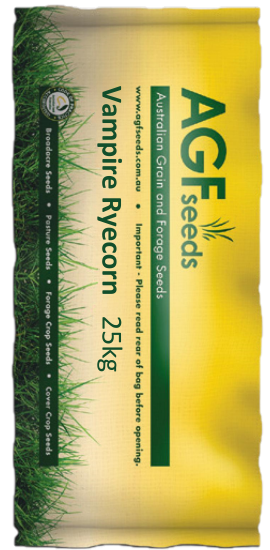
Ryecorn is a deep rooted early winter feed option. Rapid establishment provides first grazing at 4-8 weeks with good recovery allowing 3-4 grazings per season. Sown with brassica, legumes or vigourous grasses, ryecorn can provide a fast feed component toe overcome by the more nutritious pasture varieties as the ryecorn is grazed out.
Bred in Australia by the University of Sydney, Vampire ryecorn has been selectively bred to improve leaf production and mature later than common ryecorn, therefore offering greater biomass during a longer growing season. This improved productivity makes Vampire ryecorn an excellent choice for the discerning grazier.

When Daniel Hammat wanted a good grazing option for his Baderloo Merinos, he turned to Vampire Ryecorn and he’s not going back. And the good news with Vampire Ryecorn is that – like a bloodsucker in a horror movie – it keeps coming back.
Baderloo Merinos has been established for 21 years and the Hammatt family has farmed near Spalding in mid-north South Australia for 40 years where they enjoy strong hills grazing, reliable 450mm rainfall and good arable country. Daniel ventured into sowing pastures to better utilise the land and grow good feed for their Poll Merinos.
The first sowing attempts didn’t go to plan. “We’d grown an awnless forage barley in the past and it didn’t tolerate the grazing
as well, so tried Vampire Ryecorn and it has been extremely good,” he said. A client of Baderloo Merinos had been growing Vampire Ryecorn and Daniel’s
research indicated it was worth a try. “I knew it was a vigorous growing and grazing option,” he said. “You can graze it really hard and it always comes back.”
After two years, Vampire Ryecorn has met all expectations.
Daniel has sown it in April-May to capitalise on the autumn break. “We graze it through winter and then let it mature and then graze it off as a standing crop
in summertime as well,” he said. “That way you’re getting dual benefit out of it. You can graze it hard, get some spring rain and let it go and then graze the grain off it. “It’s so tolerant of heaving grazing. It’s quick to get established and you can graze it really hard and it will always come back.”
This year he sowed another round in late November after some good spring rain. “We thought we’d see how it goes over summer. Because it gets going so quick, we thought we’d try to generate some quick feed.”
Daniel is pleased with the choice. “Everything does well on it; absolutely it will stay in our system.”